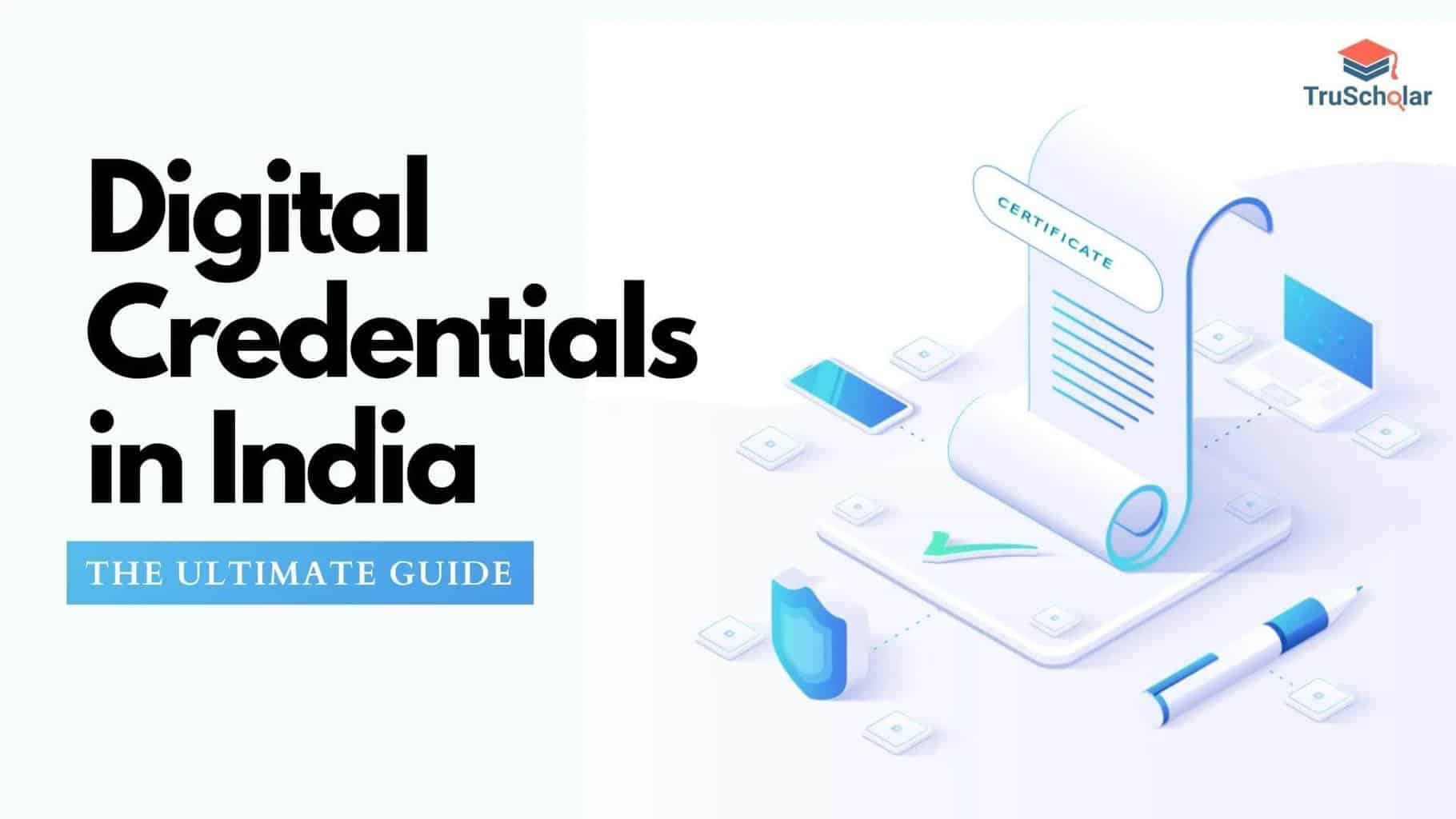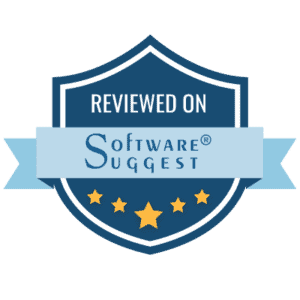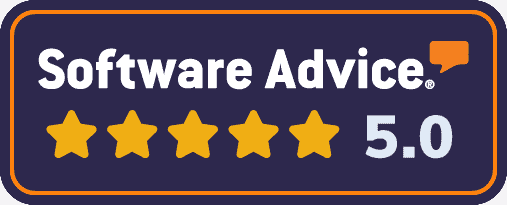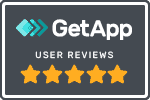Credentials define who we are. They give us identity, hope, and security. Among the many credentials we possess, education credentials define our success in life. We spend 15 to 20 years of our life obtaining them and most of us continue our learning while striving to maintain a healthy work-life balance. However, are these hard-earned credentials secure and will Digital Credentials in India make a difference?
In this digital credentials guide, we take a deep dive to explain the alarming need for secure credentials, blockchain technology’s impact on digital credentials and how the Indian education ecosystem can greatly benefit from it. Let’s get right into it.
Table of Contents
Chapter 1: The Need of The Hour
Chapter 2: Blockchain’s Role in Digital Credentials
2.1. Successful Applications of Blockchain in Education Industry
Chapter 3: Digitizing India’s Education with Blockchain
3.1. Education System in India
3.2. Critical Problems in the System
3.3. Blockchain as the Solution
3.4. Immediate Challenges for Implementation
Chapter 4. TruScholar to the Rescue
4.1. How Our Solution Works
4.2. Few of the Many Benefits
4.3. Future of Identity
4.4. Catalysts of Change
5. Conclusion
Chapter 1: The Need of The Hour
As of 2021, the creation of fake certificates and fake credentials continue to be India’s biggest problem in the education and employment sectors. Over 7,500 organizations provide fake education and employment certificates.
A vast majority of these fake documents remain unverified, and people possessing these documents continue to work peacefully in corporate, private, and public industries. It’s a shame that people who work hard don’t get proper jobs but people with fraudulent certificates get to have comfortable lives.
Not only are they fraudulent but 99% of the time they lack real talent. This lack of talent affects coworkers & companies and it’s also a detrimental factor for the overall growth of the country. Most importantly, it destroys the hope of honest and hardworking people. The sad news is that these fake numbers are only increasing.
While we do have fake universities providing fake certificates, the real problem exists in the fake certificates from established and reputed universities. We also have private institutions and well-established EdTech companies that distribute course certificates, diplomas, and degrees. Even they are at risk of facing the wrath of fraudulent forgers. More than ever, India needs a solid credential issuance and verification system which is robust, fast, and secure. What we need is Digital Credentials & Digital Credential Verification that cannot be tampered with, stolen, or illegally forged in any form or manner.
“Necessity is the Mother of Invention” – Plato
At the center of today’s world lies technology, invention, and innovation. Powered by high-speed internet, many amazing inventions continue to change our daily lives in unprecedented ways. Never in the lifetime of human existence has been a greater time.
One such influential and advanced invention of the 21st century is Blockchain Technology. It plays a pivotal role in resolving security issues across various industries. The education sector, being a key stakeholder of any thriving society, can certainly utilize the benefits.
Realizing the potential of Blockchain, the Government of India along with its policy think tank NITI Aayog, have taken an initiative to indoctrinate this technology in the education system, as part of their 2020 strategy. This decision has been the long-awaited wish come true for various educational institutions and the drive for its implementation in 2021 has only increased.
The core areas this initiative will be concentrating on are Blockchain-based credential issuance & verification, digital certificates, and digital identities across all universities.
While India has jumped on the bandwagon very recently, the universities in the west and in developed countries have already implemented blockchain in their education sector a while ago. They have also gone above and beyond a single use-case.
Along with blockchain-based credential verification, many leading universities, educational institutions, EdTech companies, and corporations, have either employed or are looking to employ this technology to improve teaching & learning activities as well as promote collaborations among students and teachers.
At TruScholar, we have been actively involved with Blockchain technology in Education for quite a while now. So, we want to educate all those looking to make a difference in our country.
Chapter 2: Blockchain’s Role in Digital Credentials
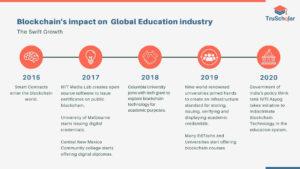
Blockchain’s Impact on Global Education Industry
Every tech inventor, from the last century till today, acknowledges that a strong foundation in education is the main ingredient for development. It is the core of a progressive society and the key to the evolution of mankind.
With the invention of blockchain, there has been a paradigm shift in the technological side of the education sector. From issuing & storing academic records to innovative teaching platforms, the applications of blockchain technology to further the global education industry are truly limitless.
Signifying this effort to make education easier, in the last decade, many institutes have evolved to adopt and implement blockchain technology. Many have experienced success; thereby boosting the confidence in the entire industry.
Not only is it limited to operational application, but as we have witnessed recently, many institutions and EdTech startups have started offering blockchain courses. It could be blockchain programming or blockchain business applications, regardless they have certainly attracted a lot of attention and increase in the audience.
Successful Applications of Blockchain in the Global Education Industry
In 2017, MIT (Massachusetts Institute of Technology) Media Lab became the pioneer in creating an open-source software that has set a standard in issuing certificates on the public blockchain. In the same year, they have started issuing digital certificates to many of its graduates.
In the same year, the University of Melbourne began issuing verified and tamper-proof digital credentials to its students. Concurrently, Central New Mexico Community College became the first to offer digital diplomas. Following the suit, in 2018, Columbia University partnered with a tech giant to explore new opportunities of this revolutionary technology.
In 2019, nine world-renowned universities joined hands to create an infrastructure standard for storing, issuing, verifying, and displaying academic credentials. These universities are Harvard University Division of Continuing Education, MIT, the University of California at Irvine, University of California at Berkeley, Hasso Plattner Institute at the University of Potsdam in Germany, the University of Toronto in Canada, the Delft University of Technology in the Netherlands, Tecnologico de Monterrey in Mexico, and the Technical University of Munich in Germany.
With such big names in the race to set the benchmark, many universities around the world have started exploring the possibilities of blockchain to their ecosystems. In aid to these pursuits, many established and new EdTech companies have joined hands to make it a global phenomenon. In that capacity, TruScholar has been a go-to provider for credential issuance and verification in India running on blockchain technology.
Also, a lot of students have started enrolling in Blockchain programs around the world. Some institutions have created specific programs for the technology. It could be a solidity programming course to create smart contracts or it could be a course on how blockchain can be used at the enterprise or business level.
All the top EdTech companies such as edX, Coursera, Udemy, Blockchain-Council, UpGrad, and many others have started advanced blockchain programs to help students get good at this technology because of the vast employment opportunities available in the space.
So, as you can see, not only is blockchain technology helping operational efficiency at institutions but it’s also creating new venues for them to improve the number of programs.
Chapter 3: Digitizing India’s Education with Blockchain
As witnessed in the last section, Blockchain has definitely created a lasting impact on global education. Now let us look at the current education system in India and how blockchain can bring a change into the system by addressing critical problems.
Education System in India
India has a vast education system with millions of graduates passing out every year. In 2019, students enrolling in higher education (graduation and post-graduation) had increased to 37 million.
We are also home to some of the brightest minds in the world. Names like Sundar Pichai, Sathya Nadella, Shantanu Narayan, and Sridhar Vembu stand as a pride to every Indian, for the major accomplishments and changes they have brought about in the tech world.
For most Indians, the fundamentals taught from a young age in the space of mathematics, science, business, and people management create a strong foundation for future growth. As it is seen, many developers from this country have achieved global success.
Some of India’s prestigious institutes such as IITs and IIMs have gained worldwide attention for their valuable contributions to the business and academic world. In fact, TruScholar is also backed with a strong tech team from IITs which enables our success.
On a whole, India’s education system continues to grow tremendously with over 900 universities and 40,000 colleges. Our elementary, primary, and high school education has also seen great changes with international syllabus and computer technologies becoming part of the curriculum. At the current rate, we are projected to be a highly educated country in the world by 2030.
EdTech Revolution
In addition to the growing population of students, we also have a great number of EdTech companies that have changed the way education is pursued. Renowned companies such as UpGrad, Unacademy, BYJUs, and Cuemath continue to educate millions of students and working professionals.
Of course, many of these institutions have started offering blockchain programs as part of their curriculum. What regular institutions and universities adapt slowly, these startups and established EdTechs employ faster.
Be it video lessons, online courses, interactive lessons, or strong tutor-student relationships, these companies have always been one step ahead. They also tie up with established universities to improve the quality of their courses.
In a larger view, institutions of all kinds are helping the country and economy grow overtime.
Critical Problems in the System
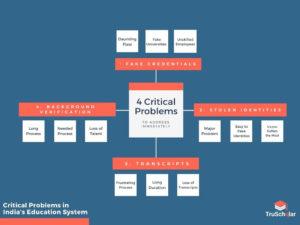
Obviously, every coin has two sides. For us to reach the projected heights of success we need to minimize or obliterate our flaws. First of all, we should never forget that we are a country of over 1 billion people. As humans, when we deal with such large entities, we are bound to make mistakes and that results in flaws becoming part of the system.
Besides the human mistakes, there are quite a few challenges from infrastructure and adaptability standpoints. Concurrently, there is a vast difference in the quality of education between tier 1, tier 2, and tier 3 cities.
While world-class education is at the tips for many people in the cities, the same cannot be said about smaller cities and towns in the country. It also becomes a challenge for students of smaller cities to compete with rich students of bigger cities as there are many financial, geographical, and psychological factors involved. Though EdTech companies are putting in their best efforts, it will take some time to make quality education available for everyone.
However, before we get there, it’s imperative that we solve our most dangerous educational problems. Blockchain technology can bring in the much-needed difference. With that said, we do want to touch base on four critical problems in the education system where an immediate change is required.
1. Fake Credentials
As mentioned at the beginning of this guide, the most daunting flaw of all is the number of fake degrees and diplomas forged and circulated every year. It is a bane not only to the education system but to the country. The number of forgers available in the country is relatively huge.
As students and colleges increase on a yearly basis, so does the number of fake certificates increase by hundreds of thousands. It is so prominent in India that almost everybody knows somebody who has a fake degree. It could be a fake high school certificate, fake university certificate, or a fake Ph.D. certificate (yes, you can get a fake Ph.D. certificate too).
According to the University Grants Commission, there are totally 24 fake universities in India as of 2019. At one point, there were nearly 39 fake universities. The enormous number of fraudulent universities gives rise to fake degrees and most importantly unskilled employees.
This phenomenon does not occur only with fake universities but also with established universities as well. There are many reputed universities that have issued certificates to individuals, who have never attended that university nor cleared any examination.
While fake degrees from fake universities can be easily found, fake degrees or diplomas from reputed organizations are often hard to track or find. Along with these massive stats comes the enormous costs required to verify and validate each individual and their credentials.
Also, there are many instances where an individual can pay someone to write their exams. It’s understood that corruption at the core is the result of this poor infrastructure and its results. Unfortunately, due to the vast size of the country and the population, it becomes practically very difficult to have a completely corrupt-free education system.
Of course, it will affect the community at large but the ones that get affected the most are companies. The loss a company bears by hiring unskilled candidates is huge. At the same time, any reputed university that somehow gives way for an unskilled candidate to pursue a prestigious degree or diploma will suffer a loss in quality.
2. Stolen Identities
A critical function of the credentials we possess is their ability to give us an identity. Along with government proofs such as Aadhar Card, Voter Card, Pan Card, etc., the high school and degree certificates give us a significant identity. When these identities are stolen or get mismatched it becomes a huge problem.
In a vast country like India, stolen identities/certificates and duplicate mark sheets are common. Along with the plague of fake credentials, comes the problem of identities. If an identity is stolen it becomes very difficult to prove who you are.
In fact, an expert in photoshop can mimic a certificate, stealing somebody else’s enrollment number. From mark sheets to degrees, every aspect of it can be perfectly replicated. If one person’s identity is stolen, it will affect two lives in return.
The person who holds the original identity and the person who’s stealing the original identity. The one that suffers more is the victim.
3. Transcripts
Another major problem that Indian students, immigrants, and job seekers face is the extremely long process of sending transcripts to foreign universities & companies to get them verified. The risks, as well as the time it takes, are very high. Not only is it a burden to the students but it also creates stringent processes for issuers of certificates, schools, colleges, and universities.
For example, most transcripts sent by candidates for the US or Canada Immigration go through the World Education Services (WES) verification process. Here’s the outline of the process:
- An aspirant submits an online application on WES which generates a reference number.
- The candidate must then send in his/her original consolidated or individual mark sheets along with the reference number to the WES office in the US.
- Upon receipt, WES executes their verification process which includes contacting the Indian institutions of the said certificates for confirmation as well as converting Indian grades to GPA equivalent.
- After successfully authenticating all the documents, they send the report to the candidate along with the original documents.
- Now, here are the drawbacks to the process:
- Your certificates can get lost at any time. It could be the negligence of the postal service or it could be the laziness of the delivery person. At the end of the day, nobody can be blamed. If it’s lost, then it’s lost. Getting duplicates of these documents is again a huge process.
- The timelines are extremely long. Even if you choose the fastest courier or delivery service, the entire process can still take anywhere between 10–15 working days. In today’s digital age, that’s a very long time.
- The costs are very high. Depending on the purpose of verification, the student/candidate will be spending anywhere between $180 — $250 approx., which includes the postal charges.
Not only is this entire process cumbersome but it also takes away time, energy, and resources. Once again, this kind of stringent process results in conmen trying to deceive innocent aspirants.
4. Employee Background Verification
Rather than a flaw, this aspect is more of a process needed. Every established company in India performs a background verification of their employees. It’s business-as-usual since companies want to know who they are associating with.
Typically, after an applicant completes an interview, the HR department or a third-party agency working with the company starts the background verification process.
While there are many steps in the verification process, the most important step is the credential verification. There are many agencies that contact the universities or run through a database of records to confirm the authenticity of the documents.
This entire process takes 3-10 days and sometimes even longer. It changes from case to case. Even recruitment agencies who provide manpower to companies need to go through the same process.
There have been hundreds and thousands of scenarios where an employee was let go after spending many weeks to months within the company. This is not only a tragedy to the employee but a huge loss to the company.
Blockchain as the Solution
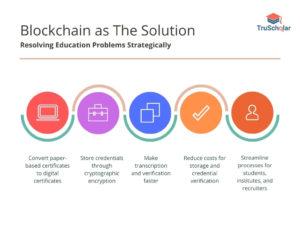
As we can see, the current processes take a lot of time and they are also very expensive. Blockchain technology has the capability to resolve these matters strategically and systematically.
If a university creates, deploys, and stores its degrees & diplomas in the asymmetric cryptographic key method used by the public blockchains then it eradicates the fake degree issues and long overhauls of verification processes.
It also makes it easier for the institutions to manage their records. There have been multiple issues where an institute takes a very long time in sending out transcripts or confirming transcripts.
So here are the solutions and various possibilities related to credentials that blockchain can resolve in the Indian Education and Employment system.
- By converting paper-based certificates to digital certificates, universities can get rid of fake degrees. They can store every single information of a student on the tamper-proof decentralized ledger which makes it harder for anyone to change. Hacking or destroying data is practically impossible on a blockchain. And theft of identity is completely negated.
- From daily class attendance to the grades achieved in tests, every detail can be stored through cryptographic encryption on to the blockchain. With the help of smart contracts, these processes can be automated. Once created, the administration team of the college can let go of the burden to keep a constant track of the information. Thanks to public and private keys available, they can access the information at any time and from any place. Alumni as well as students can also access their verified credentials at any time.
- Storing credentials on to the blockchain makes the transcription and verification processes easier and faster. It also results in better internal relationships between peers and external relationships with other universities. Most importantly, students can get enough breathing space during a verification process. By applying blockchain, the overall timelines come down from weeks & days to hours & minutes.
- The costs become less expensive for students, universities, and employers. Unlike the hundreds of dollars now being spent on storage, by implementing blockchain for storage and credential verification, it results in spending only a few dollars.
- Employers and recruitment agencies can have transparent and streamlined processes by applying decentralized ledger (blockchain) technology as part of the recruitment process Instead of concentrating on tedious processes, they can shift their focus to more important things like hiring the right candidates for a role.
Overall, there will be a paradigm shift in the way every business functions and academic departments operate. Though these are some of the immediate applications of blockchain technology, it is by no way limited to the same.
In fact, to compete with the established and developed universities of the west, Indian education system should implement the latest technologies in every possible way to advance the quality of education.
6 Major Benefits for Indian Institutions by Applying Blockchain
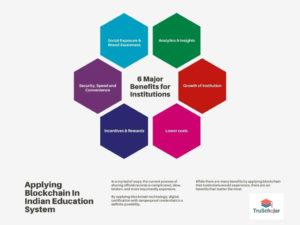
While there are many benefits that institutions will experience by applying blockchain technology, there are six benefits that matter the most. You can read more about it in this extensive article on 18 Benefits of Blockchain in the Education System.
Security, Speed, and Convenience
In a myriad of ways, the current process of sharing official records is complicated, slow, broken, and more importantly expensive.
For example, students do not have convenient and easy access to their records. At the same time, they must pay to share with others. A lifelong learner has no way to add his/her experiences and knowledge in a meaningful way to their academic records.
Refugees and displaced people, who go through a lot of physical and mental stress, will have added pressure if they lose their credentials. It becomes extremely inconvenient for them to prove their identity.
It’s been a while that employers have stopped asking for transcripts due to the extensive nature of the process. Colleges, Universities, and EdTech companies also suffer due to the lag of processes.
By applying blockchain technology to the core fundamentals of education, all these functions can be secure, faster, convenient, and easier.
Social Exposure & Brand Awareness
Imagine your students proudly flashing their digital certificates with encrypted digital keys on social media and sharing their proud moments. This will showcase that your institution is advanced, student-friendly, and most importantly trustworthy. The word of mouth spreads very fast and it leads to more enquiries, admissions, and degrees. It will improve your social ratings and your social presence. Basically, your students become your brand ambassadors.
Also, as an institution you may be spending a substantial amount of your budget on social media marketing. By introducing blockchain credentials as part of your overall student experience, you will have an added advantage in the market. You will answer the pain point of many students and learners directly. In return, you are going to get a higher ROI on your investment.
Overall your institution’s brand image and awareness will increase multifold.
Growth of Institution
As a ripple effect, brand awareness comes in the eventual growth of your institution. Now that you promote yourself as an advanced institution that provides blockchain-based digital credentials, more people will be interested to participate in your courses, diplomas, and degrees. This will lead to a higher number of enrollments and graduates.
At the same time, your retention rate will also increase. Your alumni will return to you to pursue further education. Many universities, institutions, and EdTech companies offer on-job courses or career enhancement certifications these days. If your institution does provide these and you start offering blockchain-based credentials at the end, then your alumni are going to rush back to you for taking advantage of it.
Though blockchain is a buzzword in some places, we should never that it’s an elite buzzword and with Governments of the world backing it, the attraction is only going to increase. So, it’s best for institutions and EdTech startups to implement this technology in their ecosystems as soon as possible.
Also, you don’t have to stop there. You can tie up with blockchain experts to start a blockchain program that will educate your students. In the last few years, the number of people enrolling in blockchain courses has increased tremendously. This is also another opportunity to improve the growth of your institutions. And TruScholar is just a call away if you ever consider that.
Analytics & Insights
As mentioned multiple times, your records — be it credentials, bookkeeping records, or any other records — can be secured on the blockchain, which cannot be corrupted once stored.
With a secure repository of all your records, that can be retrieved at any point in time, analyzing the trends of your growth or decline will become easier. This will help you draw insights that can help you make strategic decisions for your institution.
In the meanwhile, you can also analyze the traffic to your website or social media channels through analytical platforms, after issuing a bunch of certificates to a set of students, who will most certainly publish it on their personal social media networks.
This is what we call, one bullet – two birds.
Lower costs
The second most important benefit by applying blockchain technology is the reduction of overall costs. It is less expensive for students and universities. Lower costs will actually help students in saving money that can assist in paying off expensive student loans. Storage costs will no longer be expensive and easy to maintain with no interference from middlemen.
Incentives & Rewards
In Blockchain basics, we explained how each computer node verifies and validates the integrity of information & transactions happening on the network. They are also rewarded for the same. The nodes that verify education blockchains are rewarded with tokens. These tokens can then be exchanged for other cryptocurrencies or for fiat currencies. So, basically, nobody is facing a loss in the blockchain world.
Immediate Challenges for Implementation
Unlike the western realm, the technology infrastructure at a university level is still mediocre in many. How many universities in India have their own servers or databases or cloud systems? The numbers can be counted on fingertips.
While this is the current situation, it should not limit any university or recruitment agency out there to explore the vast opportunities possible through block chain. There are many options available.
For example, some of the best blockchain developers have their base in India. They can facilitate the transition and the selection of the right solution for a university. Universities can also choose between private and public blockchains. It’s not necessary that all universities should adopt or cling to a single blockchain.
128 In that capacity, TruScholar can help institutes, EdTech companies, and universities to migrate from paper-based or pdf-based credentials to verified and encrypted digital certificates. We will take you through our process very shortly.
TruScholar to the Rescue
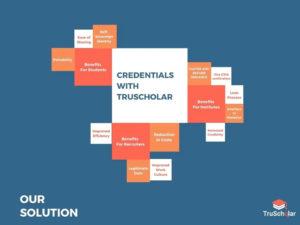
We conceptualized and created Asset Chain Techlligence Pvt Ltd, the parent company of TruScholar, with the sole purpose of bringing together the best blockchain solutions to the Indian market. It continues to be our primary ambition and purpose.
TruScholar came to fruition as we discovered the various flaws in the Indian education and recruitment system. As proud Indians, we aim to be the blockchain pioneers to bring in the much-needed technological revolution.
How Our Solution Works
Basically, TruScholar is a blockchain-based credential verification and issuance system. It enables real-time issuance and verification of tamper-proof digital records, which is the core functionality of a blockchain system. We also use this technology to create a transparent and immutable log of all digital interactions. As our system verifies the records in real-time, it reduces operational costs and eliminates dependence on third parties. Our solution is already transforming many institutions and recruitment processes.
The most important characteristics of the blockchain technology that we implement are,
- Decentralization
- Encrypted and Immutable Records
- Operational Transparency
- Ease of Provenance
- Ease of Data Retrieval
- Peer-to-Peer Based Trust System
- Self-Sovereign Identity.
We achieve the above by programming smart contracts onto established public blockchains that enable automated and continuous operations without any intervention. By doing so we make critical processes faster and easier. We also create and program our decentralized application with an unequivocal value towards students & employees while retaining the trust of institutions & employers.
Few of the Many Benefits
For Issuers who use our solutions, we offer exciting benefits such as:
- Faster and secured issuance while maintaining privacy.
- A one-click verification mechanism for faster verification.
- Reduction of unwanted preparation, checking, and printing costs.
- An interface to monetize the verification process and earn through the same.
- Easy secured storage is available for ages built on privacy by design principle.
- Increased credibility of institutes resulting in great reputation.
For Verifiers who use our solution, we offer:
- Reduction in cost: The costs for your internal and third part verifications will drastically reduce.
- Improved efficiency: Our digital platform with inbuilt trust, used by issuers, will provide instant verification.
- Legitimate data: Untampered full proof data of verifiable academic credentials
- Improved work culture: Our solution will help ease the burden on your office peers thereby increasing the fun-at-work part.
For Learners who use our solution, we offer:
- Portability: You can use our solution to create digital identity and credentials for multiple logins and verifications.
- Ease of sharing: The ability to share your credentials with anyone and at any time.
- Immutable record ledger: Permanent and Secured way of handling records for lifetime without the risk of losing physical records or PDF Files.
- Self-Sovereign Wallet: A wallet with all your identifiers in one place and the option to create your own verified digital identity.
Catalysts of Change
With our advanced blockchain features, we are confident to bring a change within the education and employment ecosystem in India. We like to challenge the status quo and be the catalysts to a disruptive shift in the way credential verification is done.
We do so while completely respecting the identities of our users in line with the GDPR and PDP guidelines. We help them create self-sovereign identities without breaching their privacy rights.
Also, we are confident and competent to declare that TruScholar has the ability to facilitate all use cases of Blockchain in education and not just credential issuance & verification.
Conclusion
We hope this digital credentials guide has given you the fundamental knowledge of blockchain technology and its various applications in the education, recruitment, and credential verification systems. In the upcoming years, we strongly believe that our enthusiasm for the technology and our robust team of engineers & blockchain experts will make TruScholar a go-to decentralized application within the EdTech space. And, as we proceed in this journey, we will continue to share our knowledge with an unwavering dedication to our loyal attendees and adherents.
We will talk to you again in our next article. Till then, take care and do reach out to us for any queries you may have. Namaste!

